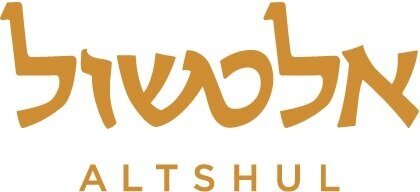Altshul Shabbat Shacharit Guidelines
Thank you so much for volunteering to lead P'sukei d'Zimra and Shacharit at Altshul this Shabbat!
Since there are many details of the service that vary from community to community, we have prepared an outline of the Altshul service that will ideally cover all issues and questions that you may have in your preparation. Please feel free to respond to this email if anything is unclear or needs further explanation.
Most importantly, though, we believe that tefilah b'tzibbur (public prayer) can and should be inspiring and uplifting. On this particular week, we are entrusting that responsibility to you. To that end, we greatly appreciate the effort you put into choosing melodies that people can sing along with and that might be different from the standard ones that are frequently used. If the melody is new, singing it once through as a niggun is often helpful. Singing is often the highlight of Shabbat morning services, and we look forward to having you lead us in it.
P'SUKEI D'ZIMRA / SHACHARIT
P'sukei D'Zimra begins at 9:30AM SHARP with Mizmor Shir Hanukat HaBayit L'David. (Birchot HaShachar are said privately, either at home or in shul before the start time for davening.)
If there is a minyan present after Mizmor Shir, the Chief Gabbai leads Mourner's Kaddish. It helps to keep an appropriate pace. If you would prefer to be the one to lead this, please tell the gabbai in advance. It’s just very important that either the Gabbai or you leads this, so as to ensure that it is said at a pace that is comfortable for all.
Continue with Barukh SheAmar straight through Shochein Ad. We encourage some singing during P'sukei D'Zimra. A designated Altshuler will call page numbers during P’sukei D’Zimra.
Continue from Shochein Ad through Yishtabach, Hatzi Kaddish, Barechu, Birchot K'riat Sh'ma, Sh'ma (allowing people time to finish).
When saying the last berakhah before the silent Amidah, it is customary to fade out on the words "Ga'al Yisrael."
At the end of the silent Amidah, look at a gabbai to confirm when to start the repetition.
If it is your practice to add the Imahot in the body of the first beracha, please do so (Sarah, Rebecca, Rachel, and Leah only please). However, please do not alter or change the concluding portion of the bracha (i.e., “Baruch ata hashem magen avraham”)
Continue with a full repetition of the Amidah. We encourage you to plan in advance to use creative tunes for the Kedushah. But please do not pick tunes that require you to repeat words in the Kedushah, particularly in the final beracha. Please remember to stand still with your feet together during the entire repetition and especially the Kedushah.
Recite the entire paragraph of Modim out loud (while the kahal says the congregational version).
Remember to add Birkat Kohanim in the repetition.
Begin Kaddish Shaleim immediately at the end of the repetition. Followed by Anim Zemirot, Shir Shel Yom for Shabbat, and Mourner’s Kaddish (gabbai will announce all three).
Immediately following mourner’s kaddish, begin the Torah Service, starting with Ein Kamokha and continuing with Vayhi Binsoa haAron. After the Vayhi Binsoa haAron paragraph, walk up to the ark while saying B'rikh Sh'mei, finishing it before the Torah is taken out. After singing "beih ana rachits ... velishlam, amein" take the Torah in your right arm and face the kahal. Do not proceed until the ark is closed. Continue with Sh'ma, Echad Eloheinu, and Gad'lu (for the last one, turn to the ark and bow slightly).
Our goal is to begin the Torah service ("Ein Kamokha") no later than 10:25AM, which leaves roughly 55 minutes for P'sukei D'Zimra and Shacharit + Anim Zemirot. (On days with Hallel, add 10 minutes to the time.)
A quick note about davening at Altshul…
While there are certain liturgical and halachic standards that we try to maintain at Altshul, we also believe that davening is most beautiful when daveners express their own styles in the way they lead services. Keeping in mind the bounds of what’s above, we encourage you to be creative and to try new things. Below are some examples:
Nusach: there are a few musical nusachim (melody modes) that are used for Psukei Dzimra and Shacharit, depending on the custom of the congregation (Ashkenazic, Sefardic, Ari, etc.). Feel free to use any of these, depending on your presonal custom.
There are numerous popular songs contained within Psukei D’Zimra. Feel free to pick a few to sing. Some examples: Hoshia Et Amecha, Torat Hashem Temima, Mi Ha-ish, Hodu, Tov L’Hodot, Ma Gadlu, Tzadik Katamar, Mikolot Mayim, Haleluya, and Ozi.
There are many sections that we typically recite silently at Altshul, but that’s not a requirement. Feel free to sing or chant some of these sections. This may include parts of the Shema or even a paragraph in Pesukei D’Zimra.
If it is your practice to add the Imahot in the body of the first beracha, please do so. While it’s Altshul’s practice to only include Sarah, Rebecca, Rachel, and Leah and to avoid changing the chatima (concluding blessing), we really do encourage you to add the Imahot if it’s meaningful to you.
Feel free to add in nigguns (wordless melodies) where you deem appropriate. The most common place this is done is before the repetition of the Amidah, and often daveners will use this moment to introduce a new melody they plan to use in their repetition.
If you’re looking for some musical inspiration, there are tons of resources online. Here are some examples:
This list is not exhaustive and there may be opportunities for other modes of personal variation. Please check with a gabbai if you’re considering other changes not mentioned above so we can all discuss together.
Thanks again! We really appreciate your putting the time into making Altshul the special davening community that we aspire to be.
